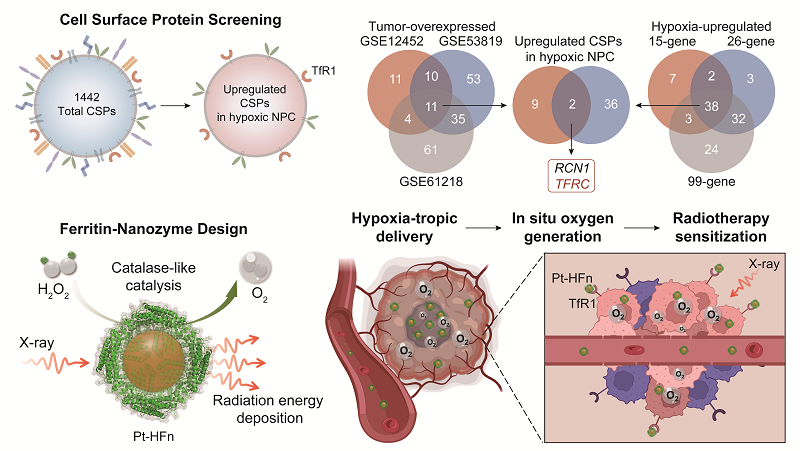A collaborative study, published on January 21 on Nature Communications, presents a novel strategy to improve the effectiveness of radiotherapy for nasopharyngeal carcinoma (NPC).
The study, conducted by researchers from the Institute of Biophysics of the Chinese Academy of Sciences, the Fifth Affiliated Hospital of Sun Yat-sen University, and Guangxi Medical University, develops a targeted nanozyme delivery system by identifying specific cell surface targets in hypoxic lesions of NPC, effectively enhancing the radiosensitivity of NPC through hypoxia-targeted delivery.
NPC, is a malignant tumor originating in the nasopharyngeal epitheliumis notoriously difficult to treat due to the tumor's severe hypoxia, which increases resistance to radiotherapy and contributes to tumor recurrence and metastasis. To address this, the study focuses on developing efficient radiosensitizers to counteract these challenges.
Nanozymes with catalase-like activity can catalyze the decomposition of hydrogen peroxide in the tumor microenvironment to generate oxygen in situ. This approach effectively avoids issues such as rapid oxygen consumption, difficult control, or significant toxicity associated with traditional methods, making it more suitable for clinical application.
In this study, the researchers first analyzed clinical samples and confirmed the significant hypoxic characteristics of NPC. Subsequently, by extensively screening thousands of proteins in a cell surface protein database, they identified transferrin receptor 1 (TfR1) as highly expressed in NPC and closely associated with hypoxia, making it a potential target for hypoxic lesions.
Thy found that human heavy-chain ferritin (HFn) could effectively target hypoxic lesions in NPC by specifically binding to TfR1. Using HFn as a carrier, the researchers loaded platinum nanozymes with both catalase-like activity and radiation energy absorption properties, creating a radiosensitizer (Pt-HFn) capable of efficiently targeting hypoxic lesions in NPC.
HFn significantly improved the dispersion of platinum nanozymes and enhanced catalase-like activity through a shell-core synergistic effect. In NPC xenograft models, the Pt-HFn radiosensitizer, leveraging the targeting ability of the HFn carrier, effectively accumulated in hypoxic lesions and exhibited excellent hypoxia alleviation and radiosensitization effects.
The results showed that Pt-HFn, when combined with radiotherapy, outperformed sodium glycididazole-a widely used clinical radiosensitizer. The treatment demonstrated superior therapeutic efficacy in both single-dose and fractionated radiotherapy models, with no noticeable adverse effects.
This study provides a novel strategy for improving the efficacy of radiotherapy in NPC, potentially offering a more targeted and effective treatment strategy for solid tumors in clinical settings.

Ferritin Nanozyme Targeting TfR1 Enhances Radiosensitivity in Nasopharyngeal Carcinoma (Image by FAN Kelong's group)






